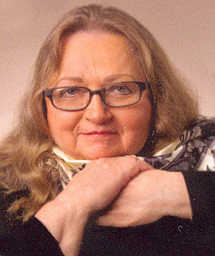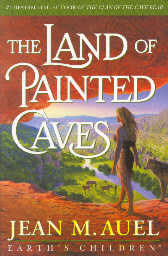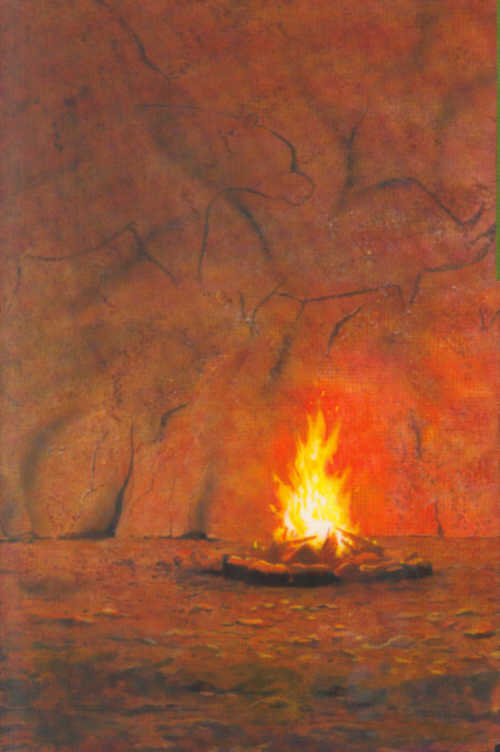Soon the remaining Cave Lions were crawling away through the bush, some of them wounded. This
hunting adventure started off the long saga of Ayla and Jondalar on their visit to the region filled with
caves decorated by artists who lived long before them. Caves filled with images of rhinoceroses,
mammoths, cave bears, hyena, aurochs, and various creatures who roamed the region. These caves can
be visited today, as the author Jean Auel did in preparation for this book. One can expect that the caves
described in this book were actual caves visited by the author.
Someone told me recently that some author she was reading wrote about the daily things that women
did around the house. I was reading this book at the time, and thought, yes, that's what Jean Auel is
doing, only it's around a cave instead of a house. Riding on horses instead of cars, pulling a travois
instead of a trailer. She describes to the reader how Ayla cooks supper, makes tea, carries around her
provisions for making tea in a pouch she always has with her. Without metal containers, Ayla and her
contemporaries used water-tight leather bowls filled with water to cook in and make tea, etc. These
bowls had hot rocks placed into them to heat up the water, soup, or stew. The rocks were placed in the
campfire and were taken from the fire with wooden tongs and dropped into the liquid.
We are told how Ayla field-dresses large game such as aurochs and dries strips over a smoking fire
which she notes, not only preserves the meat, but makes it take on the taste of the smoke and wood.
Also, Auel describes something that is rarely mentioned in literature, certainly not in Jane Austen's novels:
how and when a woman goes to urinate or replaces her menstrual padding. How their daughter was
taught to pee as a baby when she was taken outside and held up away from the cave entrance. Auel
describes all the daily activities of a woman and the materials she for cooking, cleaning, padding, clothing,
riding, or hunting, using only materials that would have been available in the region of the land of the
painted caves — what today we call France — during the early Stone Age times of Ayla and Jondalar.
This book is like a written travelogue into the earliest human times of the Ice Ages.
In addition, Auel describes how annual meetings were held and who attended. How vacations would
be taken. How visits to old friends would happen, sometimes on a long trip. How baby-sitters were
engaged, e.g., when Jondalar and Ayla went on a trip to a nearby museum — such as to one of the
magnificent painted caves.
The summer lodges were described with scrupulous detail, including how the inside walls of the
lodges were kept dry from overnight moisture.
[page 76] The ground cloth only went a short distance up the inside wall, but it
was enough to keep out drafts. Any moisture that condensed in the cool of the
evenings would form on the inside of the outer wall, leaving the inside of the
inner wall dry.
What constituted sex education for the young female virgins? A special ceremony called the Rites
of First Pleasures.
[page 85, 86] Ayla and Jondalar said their farewells and headed toward the
camps to which they had been directed. When they neared the camp of the Third
Cave, Ayla recognized the large zelandonia lodge with its ancillary lodges close
by. Right now, she thought, recalling the Summer Meeting of the year before,
the young women who were being prepared for their Rites of First Pleasures
were cloistered in one of the special dwellings, while appropriate men were being
selected for them. In the other lodge were the women who had decided to wear
the red fringe, to be donii-women this season. They had chosen to make
themselves available to the young men who were wearing puberty belts, to teach
them how to understand a woman's needs.
Pleasures were a Gift from the Mother, and the zelandonia considered
it a sacred duty to make sure the first experience of young adults was
appropriate and educational.
By her liberal and consistent use of the word "pleasures" to refer to sexual activities, Auel is able to
avoid using modern words for activities which certainly happened during Stone Age time. She does so
in a very delicate way so that even modern prepubescent youngsters might learn something about sex,
but no librarian would pull Auel's books from even her most Puritanical collections.
Have you ever met someone who was so shallow that you thought their brains were useless? After
reading this next passage, you might have to alter that opinion. Their brains would be useful for tanning
hides.
[page 208] Many of the internal organs of herbivorous animals like bison or
aurochs or any of the various deer, or mammoth or rhinoceros, were edible and
quite tasty — the liver, the heart, the kidneys — and some parts were usable.
The brains were almost always used for tanning the hides.
Auel states that the people of that region didn't have a concept of private property. That they didn't
consider that land could be owned. Yet, rightly understood, land cannot be owned, only the right to use
the land can be owned. In the definition of property as "all non-procreative derivatives of one's life" land
cannot be included because the land was there before the person acquired the rights to use it and will
be there after the person is gone or the rights have been sold. This is the most robust and useful definition
of property and I recommend to everyone(1). In her creative imagination of the Cave people, Jean Auel
formulated a version of such a definition of property.
[page 20, 21] "It is in the territory of the Fourth Cave of South Land Zelandonii,
and they consider it theirs to use and show," the First said. "They are also the
ones who would add any new paintings, usually. If Jonokol felt moved to paint
on the walls, they would probably welcome it, but it would be best if he made his
wishes known to them first. One of their own might have been feeling the need
to paint something in the same place. It's unlikely, but if that were true, it might
mean that the spirit world is reaching out to the zelandonia for some reason."
She went on to explain that it was always fitting to recognize the territory
that any Cave thought of as theirs. They didn't have a concept of private
property; the notion that land could be owned did not occur to anyone. The earth
was the embodiment of the Great Mother, given to Her children for all to use,
but the inhabitants of a region thought of their territory as their home. Other
people were free to travel anywhere, through any region, even distant ones, as
long as they used consideration and generally accepted courtesies.
Jean Auel does a great job describing the walls of the painted caves, undoubtedly recorded during
her visits to them. One can have the feeling of
walking through these caves without having to bend
down in low spaces, walk over slippery paths, re-light tallow candles to see in the dark, and without
having crane one's neck over to inspect the
ceilings. Ayla didn't know how to sing in the caves,
but she could whistle and it worked as well to ken
the size of each dark space they entered.
[page 30] "Why don't you use
your bird whistles to speak to
the Mother, Ayla," the First
said.
Ayla had heard the
woman humming, not loudly but
very melodically, and hadn't
expected to be asked. "If you
would like me to," she said,
and began a series of bird calls,
the ones she thought of as
softer evening sounds.
About four hundred feet
from the entrance, halfway in,
the cave narrowed and the
sounds resonated differently.
That was where the drawings
started. From this point on, the walls were covered with drawings of every kind.
The two walls of the winding subterranean passage were marked with almost
uncountable, often undecipherably superimposed and intermingled engravings.
Some were isolated and many that could be interpreted were very well made.
Adult women frequented the cave most often and, consequently, the more
accomplished, refined engravings were usually made by them.
Horses predominated, shown at rest and with lively movement, even
galloping. Bison were also very prevalent, but there were many other animals:
reindeer, mammoths, ibex, bears, cats, wild asses, deer, woolly rhinoceroses,
wolves, foxes, and at least one saiga antelope, hundreds of engravings in all.
Some were very unusual, like the mammoth with its trunk curled back; the head
of a lion that utilized a naturally embedded stone for the eye was strikingly
rendered; and a reindeer bending down to drink was outstanding for its beauty
and realism, as were the two reindeer facing each other. The walls were fragile
and didn't lend themselves well to painting, but were easy to mark and engrave,
even with fingers.
There were also many parts of human figures, including masks, hands,
and various silhouettes, but always distorted, never as clearly and beautifully
drawn as the animals, such as the disproportionately large limbs on the seated
figure, shown in profile. Many engravings were incomplete and buried in a
network of lines, various geometric symbols, tectiform signs, and undefined
marks and scribbles that could be interpreted many ways, sometimes depending
on how the light was held. The caves were originally formed by underground
rivers, and at the end of the gallery there was still a karstic area of active cave
formation.
When Ayla gets attacked, she and Jondalar subdue the four men led by Balderan, and take them
to the nearest cave shelter with them. Everyone recognized them as the perpetrators of multiple sexual
assaults, murders, and thefts in their own caves. The four were placed under arrest and the cave dwellers
met to discuss the fate of the four murderous thieves. A decision was made to kill them by poison and
Ayla reluctantly prepared the hemlock potion required, which could be disguised as part of the water
parsnip soup of the evening, but the four led another attack on Ayla and this time, the cave dwellers took
their own revenge on the four, leaving only one alive.
The last 200 pages of the 700 page novel were filled with excitement enough to keep pages flipping
until late into the night. Ayla remained behind from the Summer Meeting until after the Summer Solstice
(Summer Long Day) which marked the end of her year-long recording of the positions of the Sun and
the Moon on her chart, a necessary study for her as an acolyte of the First Zelandonii. When she finally
reaches the Summer Meeting already in progress, she stumbles upon Jondalar in a sexual liaison with his
former girl and in the place in the river which was special to Jondalar and Ayla. She was heart-broken
and for the first time since they first met in The Plains of Passage, she and Jondalar were separated and
their beautiful daughter Joyayla was confused as why her parents were not sleeping together.
Enjoy the long trips through the Painted Caves and get ready for the long passage through the
deepest psyches of Jondalar and Ayla which will end only the Mother knows where.
~^~
---------------------------- Reader Comments -----------------------------------------
From Anise, commenting on Bobby's blurb of this review on amazon.com titled "Field-dressing aurochs with Ayla for fun and profit" on April 25, 2014:
Well, at least this reviewer clearly read the book. I have literally not read more than 5-10 positive reviews that fit this description. Anise
~~~~~~~~~~~~~~~~~~~~~~~~~~~~~~~~~~~~~~~~~~~~~~
---------------------------- Footnotes -----------------------------------------
Footnote 1.
Details on this definition created by Andrew J. Galambos can be found in Sic Itur Ad Astra.
Return to text directly before Footnote 1.
~~~~~~~~~~~~~~~~~~~~~~~~~~~~~~~~~~~~~~~~~~~~~~
Earth's Children Series by Jean M. Auel
1. The Clan of the Cave Bear
2. The Valley of the Horses
3. The Mammoth Hunters
4. Plains of Passage
5. The Shelters of Stone
6. The Painted Caves
~^~
Any questions about this review, Contact: Bobby Matherne
~~~~~~~~~~~~~~~~~~~~~~~~~~~~~~~~~~~~~~~~~~~~~~~~~~~~~~~~~~






